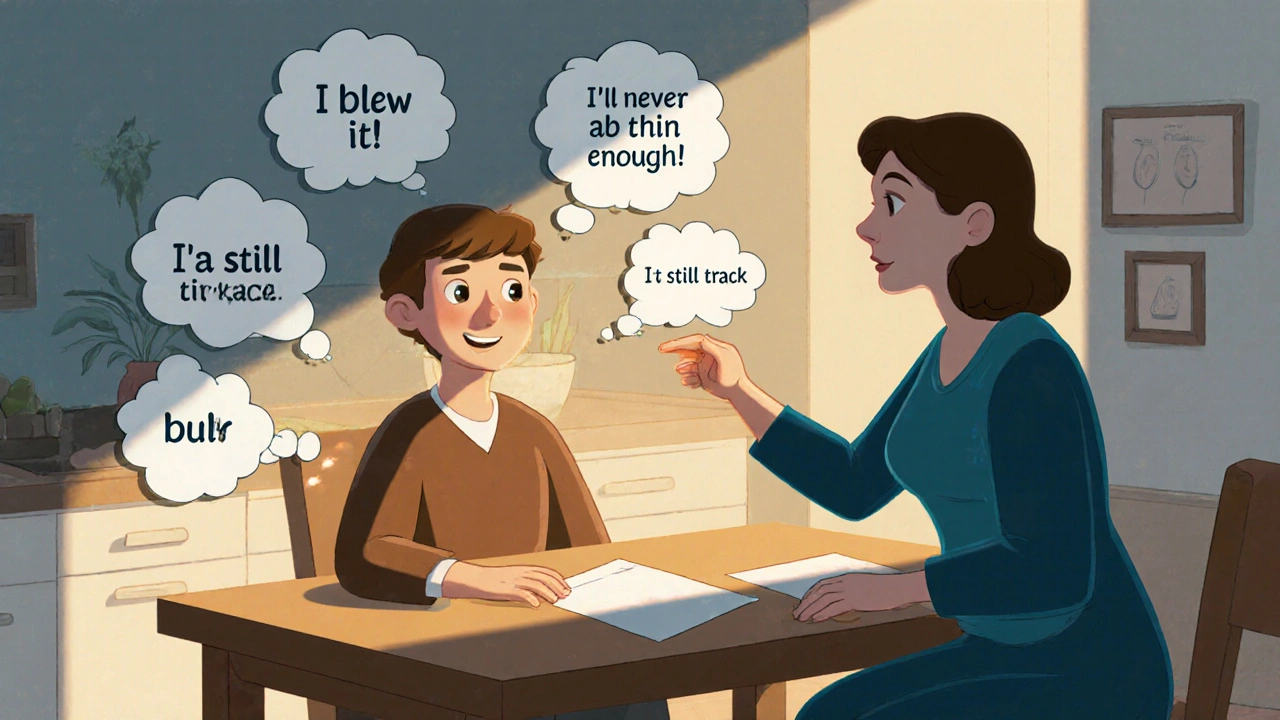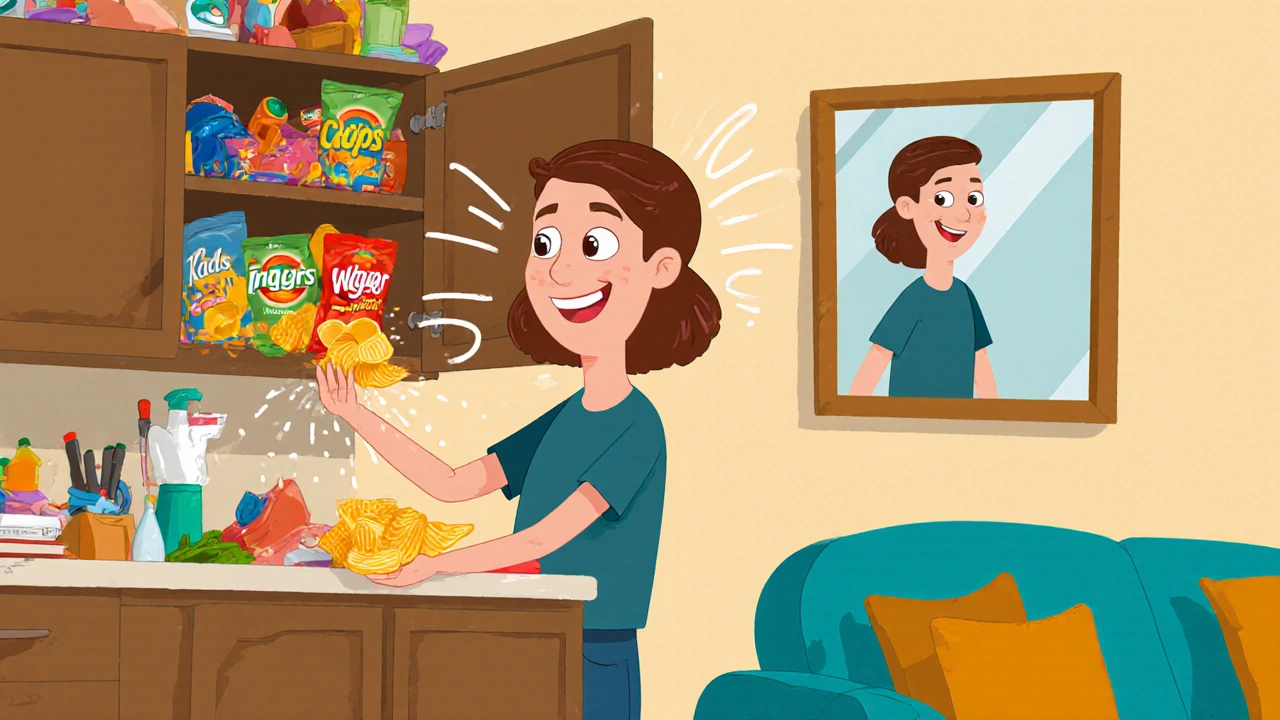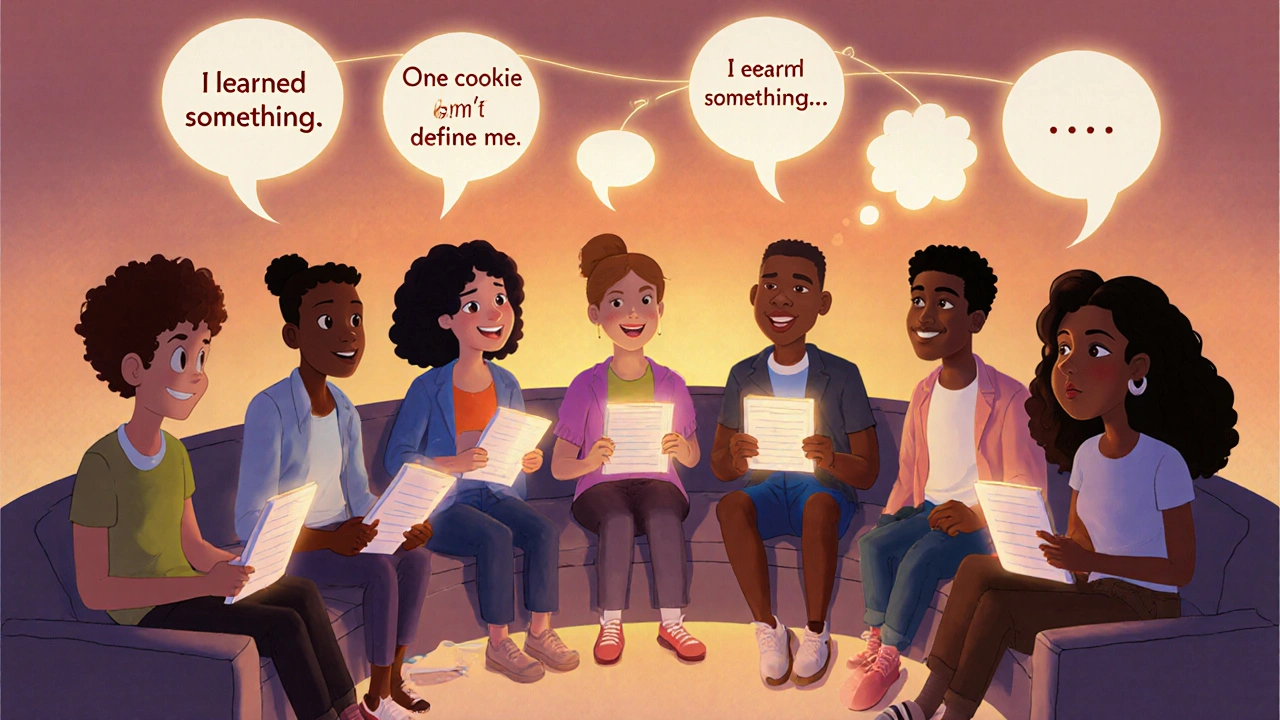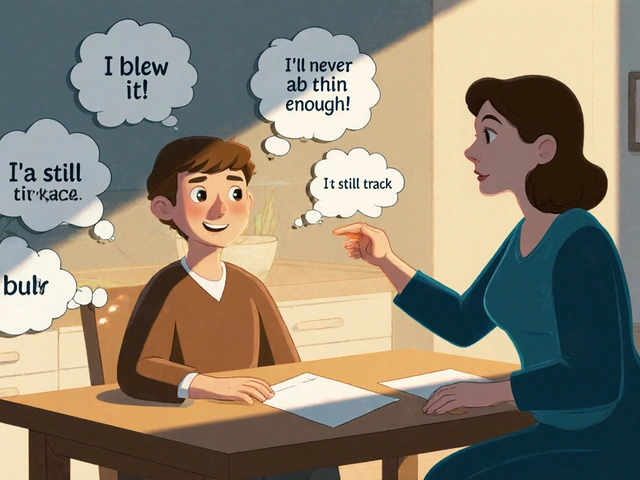
Most people who lose weight gain it back. Not because they lack willpower, but because their thoughts keep sabotaging them. You might tell yourself, "I blew it today, so I might as well eat everything," or "It’s not fair-I work out and still don’t lose weight." These aren’t just excuses. They’re cognitive distortions. And they’re exactly what behavioral weight loss therapy is designed to fix.
Why Thinking Matters More Than Diets
Diets fail because they treat weight like a math problem: calories in, calories out. But your brain isn’t a calculator. It’s a storyteller. It tells you that one cookie ruins your whole day. That you’re lazy because you skipped the gym. That you’ll never be thin enough. These stories don’t just feel true-they drive behavior. And behavior drives weight. Behavioral weight loss therapy, rooted in Cognitive Behavioral Therapy (CBT), doesn’t focus on meal plans or step counts first. It starts by changing the way you think about food, your body, and your progress. A 2023 meta-analysis of 9 studies with over 900 participants found that people using CBT lost an average of 1.6 BMI points more than those on standard diet advice. That’s not dramatic, but it’s real-and it sticks better because it tackles the root cause: your mindset.The 6 Cognitive Strategies That Work
Here’s what actually happens in a proven CBT program for weight loss:- Cognitive Restructuring: You learn to catch and challenge distorted thoughts. Instead of "I failed," you reframe it as "I had a rough meal, but I’m still on track." Studies show this cuts emotional eating by 63%.
- Self-Monitoring: Writing down what you eat and how you feel isn’t just a tool-it’s a mirror. People who keep detailed food journals lose 5-10% more weight than those who don’t. The key? Honesty. Not perfection.
- Stimulus Control: Your environment sets you up to fail. Keep chips off the counter. Don’t shop hungry. Leave the restaurant before dessert is served. Small changes to your surroundings cut automatic eating by up to 40%.
- Goal Setting: Vague goals like "lose weight" don’t work. SMART goals do: "Walk 30 minutes, 4 days a week, for the next month." Specific, measurable, achievable goals build momentum.
- Problem-Solving: You’re invited to plan for trouble. What do you do when you’re stressed? When your partner eats junk? When you’re traveling? Write down your plan ahead of time. It’s like having a mental backup system.
- Relapse Prevention: This isn’t about avoiding slips-it’s about expecting them. CBT teaches you that one cookie doesn’t mean failure. It means you’re human. The goal is to get back on track fast, not to be perfect.
Why Face-to-Face Still Beats Apps
You’ve seen the ads: “Lose weight with this app!” Apps like Noom or WeightWatchers Beyond the Scale use CBT principles-but they’re not the same as working with a trained therapist. A 2023 JAMA review found that therapist-led CBT led to 6.8% average weight loss over 6 months. Apps? Only 3.2%. Why the gap? Human connection. A therapist notices when you say, "I don’t deserve to eat well," and helps you unpack it. An app just logs it. Research from Minnesota State University shows face-to-face CBT delivers 37% better results than phone or digital-only versions. That said, digital tools aren’t useless. They’re great for reinforcement. But if you’re serious about lasting change, human guidance makes the difference.CBT Works Best When Combined
CBT alone helps-but it shines when paired with other tools. A 2018 study found that adding Motivational Interviewing (MI) to CBT boosted weight loss from 7.3% to 12.7% over 18 months. Why? MI doesn’t tell you what to do. It asks: "What’s important to you about losing weight?" That question unlocks your own motivation. It also helps with dropout rates. Standard diet programs lose over half their participants. CBT-enhanced programs keep 61% engaged. Why? Because CBT addresses the emotional barriers-shame, frustration, hopelessness-that make people quit.
Who Benefits the Most?
CBT isn’t for everyone-but it’s life-changing for some:- People with binge eating disorder (BED): More than half of BED patients no longer meet diagnostic criteria after five years of CBT.
- Those with depression or anxiety: Studies show 40% reductions in symptoms alongside weight loss. It’s not just about the scale-it’s about feeling better.
- People who’ve tried diets before: If you’ve lost weight and gained it back, CBT helps you understand why-and stop the cycle.
The Hard Truth About Long-Term Results
Let’s be real: CBT doesn’t guarantee permanent weight loss. Most people regain 30-35% of lost weight within a year. Only 20-30% maintain 10% weight loss after two years. That’s not failure. That’s human biology. The goal isn’t to be thin forever. It’s to build skills that let you manage your weight for life. CBT gives you tools to handle stress, cravings, and setbacks without falling into old patterns. That’s the real win.Barriers to Getting Started
There’s a catch. Finding a qualified CBT therapist for weight loss is hard. In the U.S., there’s only one specialist for every 125,000 people who could benefit. Many insurance plans cover only 12 sessions-far fewer than the 20-26 needed for best results. In rural areas, access is even worse. Only 15% of counties have certified CBT obesity specialists. That’s why group CBT is gaining traction. A 2022 study found group sessions delivered nearly the same results as one-on-one therapy-at one-third the cost.
What to Look For in a Program
If you’re considering CBT for weight loss, ask these questions:- Is the therapist trained in CBT for obesity? (Not just general CBT.)
- How many sessions are included? (Aim for at least 16-20.)
- Do they use structured tools like food journals and thought records?
- Do they address emotional eating and body image-not just calories?
- Is there a plan for maintenance after the program ends?
The Future: CBT Meets Medicine
New weight-loss drugs like semaglutide are changing the game. But they don’t fix your relationship with food. That’s why the NIH is funding $14.7 million in research to combine CBT with GLP-1 agonists. Early results show people on both treatments lose more weight-and keep it off longer. Why? Because medicine controls appetite. CBT controls the urge to eat when you’re not hungry. The future isn’t pills or therapy. It’s pills and therapy. The best weight loss strategy isn’t about one tool-it’s about combining them.What You Can Do Today
You don’t need a therapist to start using CBT principles. Here’s your quick starter plan:- Keep a thought journal for 3 days. Write down what you ate, when, and what you were thinking right before.
- Identify one recurring thought: "I can’t have anything good." Challenge it. Is it true? What’s a kinder, more realistic version?
- Pick one trigger-like late-night snacking-and change your environment. Put snacks in a hard-to-reach cupboard.
- Set one small, specific goal: "I will drink water before every meal for the next week."
- When you slip, don’t say "I failed." Say "I learned something."







Okay but let’s be real - if you’re not eating clean 95% of the time, no amount of cognitive restructuring is gonna help. I’ve seen people do all the journaling and reframing and still eat pizza for breakfast like it’s a spiritual practice. The brain’s just a glorified snack machine.
CBT is just therapy-speak for ‘stop being a whiny baby.’ You want to lose weight? Stop making excuses. Stop romanticizing your ‘emotional eating.’ You’re not a victim of your thoughts - you’re in charge of them. Or are you too lazy to take responsibility?
I’ve been doing some of this on my own - thought journaling, small goals like drinking water before meals. It’s not magic, but it’s helped me stop feeling like a failure every time I eat a cookie. I don’t need to be perfect. I just need to show up. And honestly? That’s enough for today.
YEAH RIGHT! THERAPISTS MAKE MONEY OFF YOUR STRUGGLES! WHY NOT JUST EAT LESS AND MOVE MORE? I MEAN COME ON! THIS ISN’T BRAIN SURGERY! I DID IT MYSELF WITHOUT ANY ‘COGNITIVE RESTRUCTURING’ AND I’M 50 POUNDS DOWN! YOU PEOPLE JUST WANT TO BE CATERED TO!
Ugh I hate when people act like CBT is some new-age cult. I’ve been in therapy for anxiety and it literally saved my life. The food journal thing? Yeah it’s annoying at first. But when you realize you’re eating because you’re lonely, not hungry? Game changer. Also I cry every time I read the part about ‘one cookie doesn’t mean failure.’
I think the real insight here is that weight loss isn’t about discipline - it’s about design. Your environment, your thoughts, your habits - they’re all systems. Fix the system, not the person. That’s why stimulus control works better than willpower. We’re not weak. We’re just poorly designed for this world.
Thanks for sharing this. I’ve been trying to find something that doesn’t make me feel broken. This actually feels like it respects the humanity of the struggle. I’m going to try the thought journal. Just three days. No pressure.
CBT is not a diet. It is a philosophy of self-mastery. In India, we call it ‘sankalpa’ - the power of resolved intention. The mind must be trained like a muscle. One thought at a time. One meal at a time. One breath at a time. This is not weakness. This is wisdom.
OMG YES. I tried the ‘one cookie doesn’t mean failure’ thing last week and I literally cried because I realized I’d been punishing myself for 10 years over a single cookie. I started journaling my thoughts before eating and now I catch myself saying ‘I deserve this’ instead of ‘I’m bad.’ It’s not about the weight loss - it’s about finally being kind to myself. 🥹✨
Stop overcomplicating it. Just move. Eat real food. Sleep. That’s it. CBT is just a fancy way to say ‘think positive.’ I lost 70 lbs with zero therapy and one dumb phone app. You don’t need a therapist - you need grit.
And who funds these ‘studies’? Big Pharma? The therapy industry? The diet industrial complex? CBT is just another product sold to people too broken to realize they’re being played. Wake up. Eat less. Move more. That’s the only truth.
So we’re supposed to believe that ‘cognitive distortions’ are the root cause of obesity? What about systemic poverty? Food deserts? The fact that healthy food costs 3x more than junk? You’re blaming the victim while ignoring the machine that keeps them hungry and hopeless.
There’s something deeply human about this. We don’t fail because we lack willpower - we fail because we’re terrified of being seen. Of being judged. Of being told we’re not enough. CBT doesn’t fix your body. It helps you stop hating the person looking back in the mirror. That’s the real weight you’re carrying.
bro just stop thinking and eat the damn pizza 🍕
Pathetic. You people treat weight loss like a spiritual awakening. It’s biology. You eat less, you burn more. Stop romanticizing failure. If you’re fat, you’re lazy. End of story. No therapy needed. Just discipline. Or are you too soft for reality?